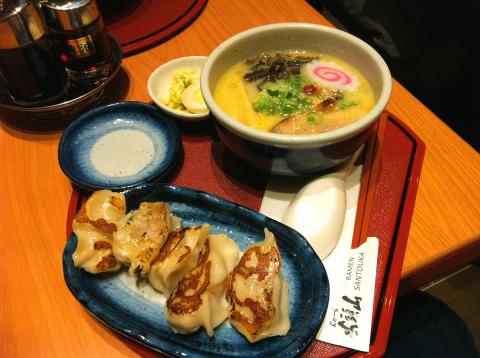If you’re going to visit Hokkaido Ramen Santouka (山頭火), a Japanese ramen chain that just opened its first Taiwanese branch in the basement food court of the Sogo Department Store on Fuxing South Road (復興南路) in Taipei, my first suggestion would be to wear a comfortable pair of shoes. A book to pass the time isn’t a bad idea, either.
Long queues of diners curious about Santouka’s self-declared “legendary” noodle soups have been the norm since the restaurant first opened in early April. The wait can take up to one hour, and the lines rival those of Din Tai Fung (鼎泰豐) at the other end of the hall.
On a visit last week, I thought I would beat the lines by arriving around 11am, when the department store opened. I was wrong. I got there at 11:10am, and already the line consisted of 25 people. It took half an hour before I was seated.

Photo: David Chen, Taipei Times
So is it worth the wait? If you’re a ramen fanatic on a constant search for the perfect bowl, then a trip is in order. I don’t consider myself an aficionado, but it was easy to appreciate the quality of the store’s specialty, the shio ramen (literally salt ramen 鹽味拉麵, NT$190, NT$220 and NT$260 for small, medium and large bowls, respectively). The broth lives up to the marketing hype on Santouka’s Web site: it does indeed taste like it was made from pork bones that had been simmered for 20 hours. The soup is hearty and well balanced, and not overly creamy as the typical Japanese ramen broth tends to be. And the requisite garlic flavor in this concoction is subtle rather than overpowering.
Such attention to detail extended to the rest of the bowl. The noodles tasted fresh and were cooked to a nice chew texture; a few thin slices of bamboo shoots and wood ear mushrooms added some crunch, and a red pickled plum, perched on top like it was a glace cherry on an ice cream sundae, was there for tartness. But what stole the show were the two slices of grilled pork, which melted in the mouth like the classic Chinese dish dongpo pork (東坡肉).
The servings in Santouka’s Shio Ramen are just a tease, though. There’s a deluxe set called toroniku ramen (山頭火特製麵, NT$290, NT$320 and NT$350), which is made from choice cuts of pork jowl meat.
Other noodle soup choices include shoyu ramen (soy sauce broth with noodles, 醬油拉麵)and miso ramen (味噌拉麵), both of which cost NT$190 for a small bowl, NT$220 for a medium and NT$260 for a large. A spicy miso ramen option (辣味噌拉麵) is also available for NT$10 extra.
Santouka recommends a medium-sized bowl for a stand-alone meal. But there is also a wide variety of side dishes, including salmon sashimi salad (鮭魚刺身沙拉, NT$160 for a single order), fried pork cutlet (日式炸豬排, NT$180) and Japanese-style pot stickers (煎餃, NT$160). I ordered the latter and found them to be a nicely done and lighter version of the Northern Chinese variety. They have a thinner skin and are cooked until the bottom is crispy.
These dishes are all available as part of combo sets that come with a small bowl of noodles (your choice of broth flavor) and a boiled egg, with prices ranging from NT$330 to NT$360.

June 2 to June 8 Taiwan’s woodcutters believe that if they see even one speck of red in their cooked rice, no matter how small, an accident is going to happen. Peng Chin-tian (彭錦田) swears that this has proven to be true at every stop during his decades-long career in the logging industry. Along with mining, timber harvesting was once considered the most dangerous profession in Taiwan. Not only were mishaps common during all stages of processing, it was difficult to transport the injured to get medical treatment. Many died during the arduous journey. Peng recounts some of his accidents in

“Why does Taiwan identity decline?”a group of researchers lead by University of Nevada political scientist Austin Wang (王宏恩) asked in a recent paper. After all, it is not difficult to explain the rise in Taiwanese identity after the early 1990s. But no model predicted its decline during the 2016-2018 period, they say. After testing various alternative explanations, Wang et al argue that the fall-off in Taiwanese identity during that period is related to voter hedging based on the performance of the Democratic Progressive Party (DPP). Since the DPP is perceived as the guardian of Taiwan identity, when it performs well,

A short walk beneath the dense Amazon canopy, the forest abruptly opens up. Fallen logs are rotting, the trees grow sparser and the temperature rises in places sunlight hits the ground. This is what 24 years of severe drought looks like in the world’s largest rainforest. But this patch of degraded forest, about the size of a soccer field, is a scientific experiment. Launched in 2000 by Brazilian and British scientists, Esecaflor — short for “Forest Drought Study Project” in Portuguese — set out to simulate a future in which the changing climate could deplete the Amazon of rainfall. It is

The Taiwan People’s Party (TPP) on May 18 held a rally in Taichung to mark the anniversary of President William Lai’s (賴清德) inauguration on May 20. The title of the rally could be loosely translated to “May 18 recall fraudulent goods” (518退貨ㄌㄨㄚˋ!). Unlike in English, where the terms are the same, “recall” (退貨) in this context refers to product recalls due to damaged, defective or fraudulent merchandise, not the political recalls (罷免) currently dominating the headlines. I attended the rally to determine if the impression was correct that the TPP under party Chairman Huang Kuo-Chang (黃國昌) had little of a